
(Image from Harry Potter Wiki)
Given that the stories take place in a world populated by wizards and witches wielding magic, much of the 'wildlife' appearing in the stories are completely fictitious. Unfortunately, muggles like us will never get the chance to learn more about acromantulas, Hungarian horntails, phoenixes, hippogriffs, or basilisks. However, there is one group of animals that are very real creatures indeed, the owls.
I covered the owl species that can be found in Singapore over at the Celebrating Singapore's Biodiversity blog, so here I will be talking about the owl species that are featured in the Harry Potter stories. A lot of information about the owls in the books and movies is available on this page by bird enthusiast Laura Erickson ("Professor McGonagowl").
The most famous owl of all in the series would be Harry Potter's familiar Hedwig, a snowy owl (Bubo scandiacus).

(Photo by vicers5)
Snowy owls are Arctic specialists, living on the frozen tundra of Alaska, Canada, Greenland and Eurasia. During the winter months, they are migratory, with many moving south towards more temperate climates. In some years, irruptions occur, in which large numbers of snowy owls fly even further south, reaching areas where they would not normally be found. The reason behind such mass movement is unknown; it used to be thought that these were starving birds dispersing in search of food in response to crashes in lemming populations, but this is far from confirmed.
The main prey of the snowy owl consists of rodents such as mice and voles, although it will also take hares, birds such as ptarmigan and waterfowl, and even fish and carrion. Lemmings are especially important to snowy owls, forming a major part of the snowy owl diet; adults are able to raise more young in years when lemming numbers are booming. Unlike many owl species, the snowy owl is often active during the day, and since there are no trees in the tundra, its nest is a shallow depression in the ground.

It is clear how the white plumage of the snowy owl helps to conceal it from potential prey;
(Photo by FrancoisBoucher)
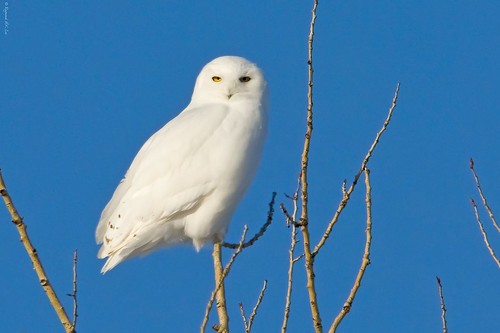
While female snowy owls retain dark streaks throughout their lives, some males may turn completely white with age. This means that Hedwig, which is supposed to be female, is actually played by male owls in the movies!
(Photo by Raymond Lee Photography)
While the snowy owl has been classified in its own genus (Nyctea), DNA analysis revealed that it is in fact a member of the eagle owls (Bubo spp.), and so is now considered to belong to that genus. Some of its unique features, such as the almost-complete loss of ear-tufts, as well as its white coloration, can be seen as adaptations to its Arctic habitat.
In popular culture, a photo of a snowy owl with a funny expression on its face is the basis of the "O RLY?" Internet phenomenon.

JK Rowling had this to say about her portrayals of Hedwig as being largely nocturnal, even though snowy owls do spend a fair bit of time hunting in the day:
Only after Philosopher's Stone had been accepted for publication did I realize that Snowy Owls are diurnal. I think it was during the writing of Chamber of Secrets that I discovered that Snowy Owls are also virtually silent, the females being even quieter than the males. So all of Hedwig's night-time jaunts and her many reproving hoots may be taken as signs of her great magical ability or my pitiful lack of research, whichever you prefer.Harry Potter's rival at Hogwarts, Draco Malfoy, is also accompanied by an owl, although it is not heavily featured in the stories. The Malfoys' owl is an Eurasian eagle owl (Bubo bubo).
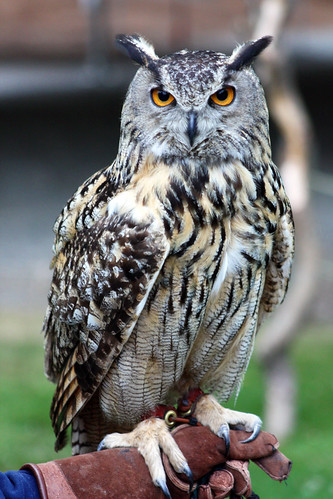
(Photo by jaden_alexander)
This is one of the largest owl species, with a wingspan of up to 2 metres, a body length of 60 to 75 centimetres, and large females capable of reaching 4.5 kilograms in weight. Widely distributed across temperate Eurasia, from Europe and northern Africa to Korea and Hokkaido, the Eurasian eagle owl may be found in many habitats, from coniferous forest to the edges of deserts, with a preference for rocky areas that provide nesting sites. This adaptable species is known to inhabit farmland and even urban areas; several are known to live in Helsinki, with breeding taking place recently. One of these owls made the news in 2007, when it landed in a stadium during a football match between Finland and Belgium, interrupting gameplay for six minutes.
Given its size, the Eurasian eagle owl is an immensely powerful predator, feeding not just on rodents and small birds, but also prey as large as marmots, hares, grouse, geese, and even foxes and small deer. Even prickly hedgehogs are also preyed upon by this species! Interestingly enough, the Eurasian eagle owl is known to prey heavily on smaller birds of prey, feeding on smaller species of owl, as well as hawks and falcons. Formerly extinct in the British Isles, recent recolonisation and records of breeding by Eurasian eagle owls (possibly due to escapees from captivity or natural dispersal from mainland Europe, or a mixture of both) has led to some concern about the potential impact on prey species, especially since many native birds are already threatened and might not be able to sustain predation by such a formidable hunter. Other conservation groups, on the other hand, hail this as the return of a former native.

Eurasian eagle owl, England;
(Photo by hantslad)
I stumbled upon this hilarious illustration, showing how JK Rowling might not have done a lot of research on the owls she mentions in her stories, at least when she first began writing them.

Harry Potter and the PSA
(By lyosha on deviantART)
Harry Potter's best friend, Ron Weasley, started out with a rat named Scabbers for a familiar. But Scabbers turned out to be the wizard Peter Pettigrew, who was an Animagus (a wizard or witch knowing the ability to morph into the form of a specific animal at will), and had remained hidden as a rat for twelve years. Subsequently, Ron's new familiar was an Eurasian scops owl (Otus scops) named Pigwidgeon.
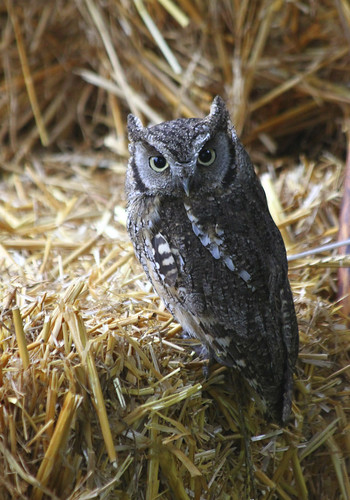
(Photo by Zaffiro&Acciaio)
Compared to the Eurasian eagle owl, this is a much smaller species, with a wingspan that is just around 50 centimetres, and a body length of 20 centimetres. Breeding in forests and woodlands of southern Europe and north Africa across to the Middle East and central Asia, it is migratory during the winter months, with many populations flying south to sub-Saharan Africa. As befits its size, the Eurasian scops owl feeds on small prey, with a great deal of its diet consisting of large insects such as grasshoppers, cicadas, moths and beetles, as well as other invertebrates such as earthworms and spiders. Small vertebrate such as lizards and birds may also be taken.

Eurasian scops owl with grasshopper prey;
(Photo by Les Frères des Bois)
Based on the promotional material for the movies, Pigwidgeon is portrayed by a white-faced owl (Ptilopsis sp.).

Formerly, there was only one species of white-faced owl, bearing the name of Ptilopsis leucotis. A native of the savanna woodlands in tropical Africa, this species was once included among the scops owls, and was hence known as the white-faced scops owl. Subsequently, due to differences in its call and its distinctive facial markings, it was split off as a separate genus (Ptilopsis) in 1851. For most of the 20th century, Otus was a grab bag of miscellaneous small owls with ear tufts, some of which were clearly not very closely related to one another. Genetic analysis not only confirmed that the white-faced owl did not belong with the scops owls, it was in fact made up of two species, the northern (Ptilopsis leucotis) and the southern (Ptilopsis granti). Both species look very similar, and are differentiated largely by DNA and the fact that each species has a different call. Where it comes to distribution, the two species are roughly divided by the Equator.
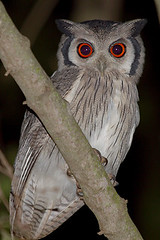
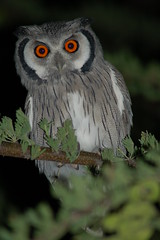
Left: Northern white-faced owl, Uganda;
(Photo by gipukan (rob gipman))
Right: Southern white-faced owl, Botswana;
(Photo by Sara&Joachim)
The confusing taxonomy of white-faced owls is far from settled; it turns out that the southern white-faced owl should bear the Latin name of Ptilopsis erlangeri, although the issue is far from settled.
The southern white-faced scops owl is the star of this clip from a Japanese variety show, which has been making its way around the Internet.
In this clip, the white-faced owl displays how it responds to threats of different sizes. A barn owl (Tyto alba) is not much bigger than the white-faced owl, so the latter puffs itself up and spreads its wings to appear larger and more intimidating. This is a common strategy employed by many species of owl when faced by a potential predator. However, when confronted by a Verreaux's eagle owl (Bubo lacteus), a much larger species, the white-faced owl flattens its feathers and puts up its best imitation of a tree branch. This is a strategy seen in many smaller owls, which rely on their camouflage to prevent detection by predators.
Ron Weasley's older brother, Percy, also has a small owl, a screech owl called Hermes.
Screech owls, small owls with ear tufts found in the Americas, are another group once thought to belong to the same genus as the scops owls. However, they are now classified under their own genus, Megascops. The most well-known representative would be the eastern screech owl (Megascops asio), native to deciduous forests and woodlands in eastern North America. Harry's Nimbus 2000 was delivered by six screech owls.
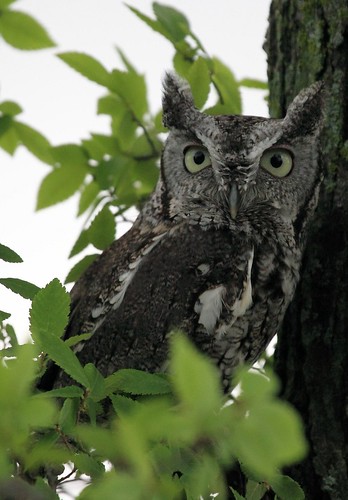
(Photo by Sheribeari)
The Weasley family's old and accident-prone owl, Errol, is a great grey owl (Strix nebulosa).
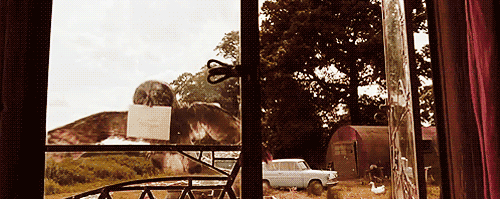
(Animated GIF from Tumblr)
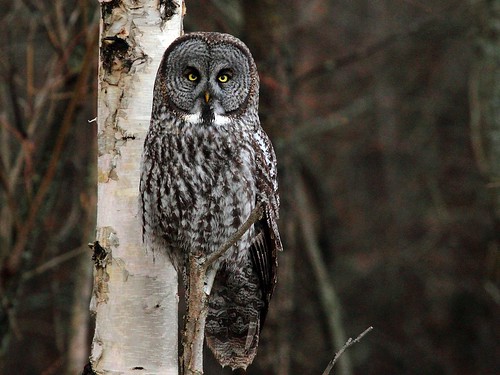
(Photo by Richard Chamberland)
This owl is another very large species, with the longest body length of all, possibly reaching up to 82 centimetres. However, with its wingspan of around 1.5 metres, it loses out to the Eurasian eagle owl and other species in this regard. And despite its size, it is outweighed by other owls, since a lot of its mass is actually made up of feathers.
The great grey owl is adapted to the coniferous forests of North America and northern Eurasia. Here, its dense plumage insulates it from the cold, and its excellent sense of hearing enables it to pick up the faintest rustling of prey scurrying about in tunnels beneath the snow.
Small rodents such as voles and mice are the primary food source of this species, which can be seen hunting not only at night, but also in the early morning and late afternoon hours. Hunting purely by sound, this owl is capable of detecting prey moving around beneath a layer of snow as much as 30 centimetres deep. The owl swoops and plunges into the snow, capturing its prey with astonishing accuracy.

(Photo by Nature's Photo Adventures - David G Hemmings)
Needless to say, great grey owls are not as clumsy as their onscreen representative; in real life, an owl would not normally survive such crashes as depicted in the books and movies, since bird bones are hollow and far too fragile. The movie sequences are a mixture of footage of real owl actors flying, as well as CGI and stuffed owls for the impact scenes.
Still, accidents do happen, and this real-life incident reminds me way too much of poor Errol. I just hope the owl wasn't too badly hurt and flew off. Apparently, this isn't the first time this has been recorded, with various other birds leaving their imprints on window panes, and similar incidents involving owls dating back to 2002 and 1982.

Owl's imprint on window pane, England;
A couple of other species of owl appear in the stories, but do not feature prominently as the familiars or companions of any of the major characters.
Many of the miscellaneous owls seen delivering letters are tawny owls (Strix aluco), also believed to be the species that left the imprint in the window. A species known as the brown owl is also mentioned in the stories, but the name probably refers to the tawny owl as well.

(Photo by Lathers)
This is one of the most common owls in many parts of Europe, inhabiting deciduous forests and woodlands, and also occupying suburban parks, gardens and cemeteries. It has a wide distribution across north Africa and most of Europe to Iran and western Siberia, as well as the Himalayas, southern China, Taiwan and Korea. Tawny owls feed on a wide range of prey, from earthworms and beetles to birds, mice, shrews and bats.
The final species featured in the Harry Potter stories is the barn owl.
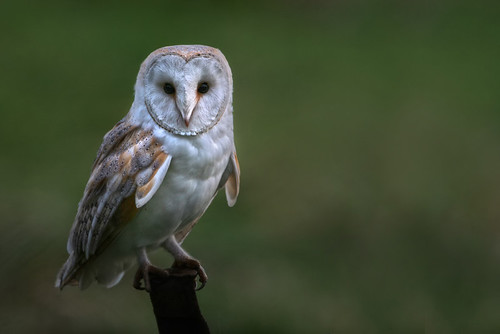 (Photo by nigel pye)
(Photo by nigel pye)This species is widespread and has a nearly global distribution, being found on every continent except Antarctica. Preferring to hunt over open fields and woodlands, this owl earns its name from its habit of nesting in buildings, such as in barn lofts and attics. In Peninsular Malaysia, nest boxes have been set up to encourage barn owls to breed in oil palm plantations and rice fields, hence providing an excellent pest control service by preying upon the rats that would otherwise consume and damage crops. Other prey items include birds and large insects.

(Photo by Dries Gaerdelen)
This is also the only species of owl from the Harry Potter stories that can be found in the wild in Singapore.
These are the various owl species that appear in the Harry Potter stories, although I'm not sure if there are other species that make cameo appearances in the movies. I suppose I'll have to watch all the movies all over again, carefully pausing at scenes featuring multiple owls, such as when the owls are making their morning mail deliveries at Hogwarts, or at Eeylops Owl Emporium in Diagon Alley.


Screen captures of Eeylops Owl Emporium as depicted in the movies. Say, is that a spotted wood owl (Strix seloputo) in the background of the picture below? Then there's at least one more species of owl occurring in Singapore that we've seen in the Harry Potter movies.
(Images from Harry Potter Wiki)
In the movies, owls perform many feats that would be considered difficult or even dangerous for a real owl. As a result, many scenes are actually a blend of footage of owl actors combined with stuffed owls and CGI effects. Some of this information can be seen in reviews done by the American Humane Association, ensuring that animal actors are not harmed, stressed, or otherwise subjected to cruelty and mistreatment in the filming process. Here are the pages for the 7 movies released thus far.
- Harry Potter and the Philosopher's Stone (Harry Potter And The Sorcerer's Stone for American audiences)
- Harry Potter and the Chamber of Secrets
- Harry Potter and the Prisoner of Azkaban
- Harry Potter and the Goblet of Fire
- Harry Potter and the Order of the Phoenix
- Harry Potter and the Half-Blood Prince
- Harry Potter and the Deathly Hallows: Part 1
Owls have great cultural significance around the world. For example, in Europe, owls are associated with Athena, Greek goddess of wisdom. Yet at the same time, they may also be seen as bad omens and harbingers of death; the Aztec god of death, Mictlantecuhtli, was often portrayed with owls.
Even today, there are two stereotypical representations of owls in pop culture. There is the wise and knowledgeable owl, and then there are owls portrayed as fiendish creatures of the night. For the latter, if they are not ghostly apparitions out to kill the protagonists, they are often employed as part of the scenery to add to the suspense and creepiness with their eerie presence.
Besides Harry Potter, there are a number of other famous owls in literature, movies and television.
A classic animated short from 1936, I Love to Singa depicts a young jazz-singing owl who struggles to find acceptance from his classical-inclined parents.

(Image from Winniepedia)
Another famous fictitious owl is Owl from the Winnie the Pooh stories.
An owl named Glimfeather assists the protagonists in The Silver Chair, part of the Chronicles of Narnia series. The fourth chapter is also given the title of A Parliament of Owls, which reflects the term for a group of owls.

(Image from The Disney Wiki)
Archimedes is the pet of Merlin in The Once and Future King, a retelling of the story of King Arthur. In the Disney movie adaptation of the section entitled The Sword in the Stone, Archimedes is able to speak, and provides the comic relief for the film.

(Image from The Disney Wiki)
Friend Owl is one of the main characters in the Bambi movie.

(Image from The Disney Wiki)
Similarly, Disney's The Fox and the Hound has a talking owl named Big Mama.

(Image from Muppet Wiki)
Hoots the Owl from Sesame Street is a jazz musician who plays the saxophone.

(Image from Random Pudgie Thoughts of Goodness)
Owls appear in other films from the late 20th century; in Jim Henson's Labyrinth, the Goblin King Jareth is able to take the form of a barn owl. The Great Owl in The Secret of NIMH (pictured above) is scary and huge compared to the rodent protagonists, but is ultimately a benevolent and wise character who offers cryptic advice. On the flipside, the magical Grand Duke and the other owls in Rock-a-Doodle are portrayed as the villains, and are afraid of light.

(Photo from Eclectric Dragonfly)
Even the original 1981 Clash of the Titans had a mechanical owl named Bubo, which had a cameo appearance in the 2010 remake. Blade Runner had a scene with a realistic-looking owl that according to the dialogue, was artificial and very expensive.

(Image from edopter.com)
Superhero comics also have characters based on owls, such as Nite Owl (pictured above), one of the main characters of Watchmen. Owlman (DC Comics) and Owl (Marvel), on the other hand, are supervillains.


(Images from Bulbapedia)
The Pokémon Hoothoot and Noctowl are clearly based on owls.

(Image from Avatar Wiki)
In Avatar: The Last Airbender, there is an ancient, wise, and immensely powerful spirit called Wan Shi Tong, which maintains a massive collection of books called the Spirit Library, and takes the form of a giant barn owl.

(Image from FilmoFilia)
There is another series of books that features owls, except that this time around, most of the main characters in the stories are actually owls. The Guardians of Ga'Hoole series, written by Kathryn Lasky, consists of 15 books, and a film adaptation was released last year.
In other more whimsical portrayals, everyone is fond of owls, except for Simon Cowell. And I particularly love these segments from Walk on the Wild Side, blending BBC documentary footage and voiceovers to get hilarious results.
In a similar vein, there's also a Tumblr site called Hungover Owls, and a recent Flickr Blog entry entitled Owls with Stupid Expressions on their Faces.
And in Rango, one of my favourite animated films, there is a mariachi band of owls that provide narration and music.
For more information about owls, there are some excellent articles by Darren Naish, who blogs at Tetrapod Zoology. In the previous version of his blog, hosted at ScienceBlogs, Darren wrote a few posts about owls, such as an overview and summary of owl biology, giant owls of Pleistocene Cuba, adaptations of fish owls, and possible similarities between owls and the theropod dinosaurs known as troodontids. Darren also examined an owl pellet, and raised the question of why some owl species possess ear tufts but not others.